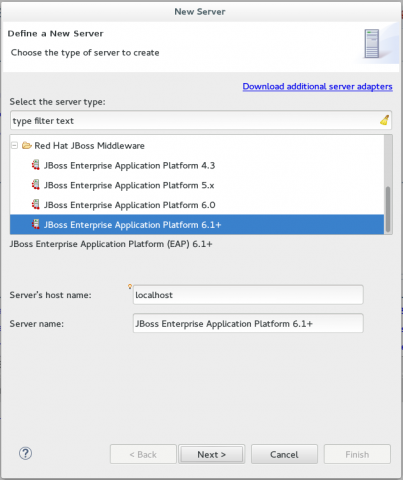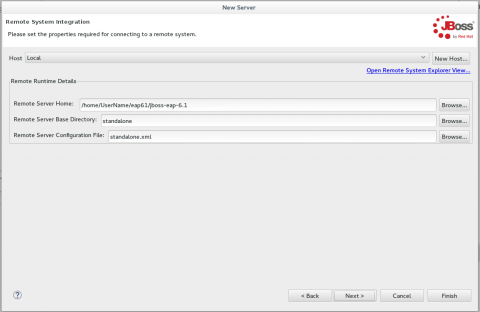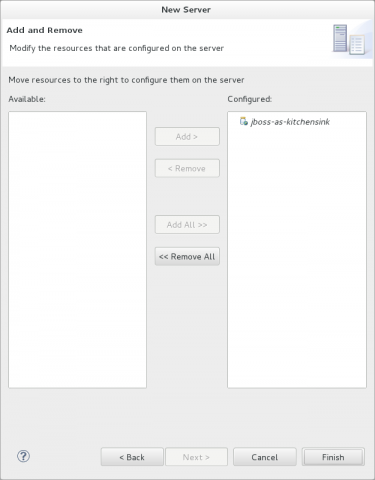Configure a Remote Server in Red Hat JBoss Developer Studio 8.x
Important: This article is intended for use with Red Hat JBoss Developer Studio 8.x. See Configure a Remote Server in Red Hat JBoss Developer Studio 9.x for instructions about performing these tasks with a newer version of JBoss Developer Studio.
Configure a Remote Server
Remote servers allow developers to access and deploy to a JBoss instance that is not a local machine. Developers can use remote servers to set up multiple development environments for development and testing purposes and share them with other developers. Another reason to use a remote server with Red Hat JBoss Developer Studio is to allow developers to share and deploy automated tests to run in a non-local environment.
The following instructions are used to set up a remote server for JBoss Enterprise Middleware application servers. A complete server definition requires a server adapter (or server) that allows the IDE to communicate with and manage the remote server.
Configuring a Remote Server
- Click the Servers view. If the Servers view is not visible, click Window→Show View→Servers.
- Use the appropriate instructions depending on the number of existing servers listed in the Servers tab:
a. If there are no existing servers, click No servers are available. Click this link to create a new server...
b. If there are one or more existing servers, right-click an existing server and click New→Server. - In the New Server wizard, add the relevant information for the following fields:
a. From the Select the server type list, select a JBoss Enterprise Middleware application server.
b. The Server's host name and Server name fields are completed by default. In the Server name field, you can type a custom name by which to identify the server in the Servers view.
c. Click Next > to continue.

- Configure the required Server Adapter details:
a. For the The server is field, click the Remote radio button option.
b. For the Controlled by field, select either the Filesystem and shell operations or Management Operations radio button option depending on your requirements.
Note: If you select Management Operations for the Controlled by field, you must set up an admin user on the server by using the $SERVER_HOME/bin/add-users.sh script (for Linux, or the $SERVER_HOME\bin\add-users.bat file for Windows) and enter the same credentials in the server editor or during the server start.
c. The Server is externally managed. Assume server is started field is used when the user wants to deploy the server but does not want the IDE to stop or start the server for them. Depending on the requirements, select this check box or leave it unchecked, as is default.
d. A remote server can now be created without assigning a runtime to it. Depending on the requirements, select the Assign a runtime to this server check box (and select an existing runtime or create a new one) or leave the box unselected.

- Add the remote system integration details as follows:
a. In the drop-down menu, select the appropriate host type in the Host field.
i. The default host is Local.
ii. If required, use the New Host button to create a new host, which may be remote or local. Supported connection types for remote hosts areFTP OnlyorSSH Only.

b. Add the Remote Runtime Details as follows:
i. Specify a path to the directory that contains the remote server in the Remote Server Home field.
ii. Specify the remote server’s base directory (the default value for this is the standalone directory within server home directory) in the Remote Server Base Directory field. This location is within the Remote Server Home directory (specifically in the $SERVER_HOME/BASE_DIRECTORY/configuration/ directory).
iii. Specify the file to use for the remote server’s configuration (the default value for this is the standalone.xml file) in the Remote Server Configuration File field. This location is within the Remote Server Home directory (specifically in the $SERVER_HOME/BASE_DIRECTORY/configuration/ directory).
iv. Either click Next > to continue to the (optional) next step to add or remove server resources or click Finish to conclude the new remote server configuration.

- Optional: Add or remove resources configured on the server as follows:
a. To add a resource, select the appropriate resource in the Available pane and click Add >. To add all available resources, click Add All >>.
b. To remove a resource, select the appropriate resource in the Configured pane and click < Remove. To remove all configured resources, click << Remove All.
c. Click Finish to complete the server configuration.

Result: You have successfully configured a remote server. The new server is listed in the Servers tab. Right click the server to view operations, including Start to start the server.
Note: If the Server is externally managed. Assume server is startedcheck box was selected in step 4, clicking Start does not start the server. Instead, it marks the server to indicate that it has started and the web poller checks whether the server is running.


Comments